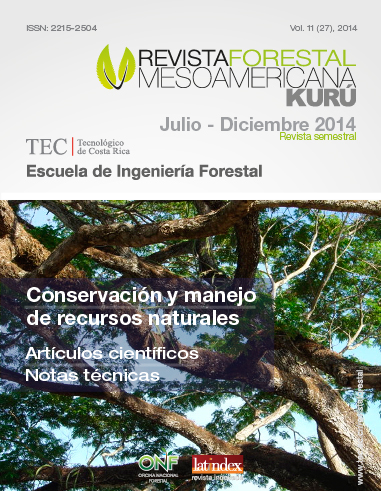Estimating aboveground biomass for Eucalyptus saligna Sm. and Eucalyptus camaldulensis Dehn in the center region of Costa Rica
Contenido principal del artículo
Resumen
The contribution of forests as climate change mitigation sinks through growth production calls for the accurate determination of their biomass production, therefore it is necessary to to evaluate variables such as weight of dry leaves, diameter at breast height (DBH) , diameter at stump height (DSH) and total height and their effect on individual aboveground biomass. The analysis was conducted at theTechnological Institute of Costa Rica (TEC) located in the province of Cartago- Sampling consisted on 31 sampling of Eucalyptus saligna and Eucalyptus camaldulensis, in order to estimate a linear regression model to predictaverage tree biomass. The final model obtained for biomass was Biomasa = e^2,6915+2,1338*√DSHi, with a coefficient of determination of 0,9061. We recommend a study to help determine the biomass and soil organic matter to provide a complete inventory of biomass for a given area.
Detalles del artículo
Cómo citar
[1]
R. Navarro-Camacho, E. Esquivel-Segura, E. Briceño-Elizondo, y D. Arias-Aguilar, «Estimating aboveground biomass for Eucalyptus saligna Sm. and Eucalyptus camaldulensis Dehn in the center region of Costa Rica», RFMK, vol. 11, n.º 27, pp. 22–33, jun. 2014.
Sección
Artículos científicos
Revista Forestal Mesoamericana Kurú is licensed under CC BY-NC-ND 4.0
Al enviar un artículo a la Revista Forestal Mesoamericana kurú (RFMK), los autores ceden los derechos patrimoniales a la editorial de la RFMK una vez su manuscrito haya sido aprobado para publicación, autorizando a la RFMK a editarlo, reproducirlo, distribuirlo, y publicarlo en formato físico y/o electrónico. La titularidad de los derechos morales sobre los trabajos objeto de esta cesión seguirá perteneciendo a los autores.

